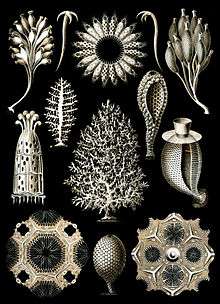Calcareous sponge
The calcareous sponges[1] of class Calcarea are members of the animal phylum Porifera, the cellular sponges. They are characterized by spicules made out of calcium carbonate in the form of calcite or aragonite. While the spicules in most species have three points, in some species they have either two or four points.
| Calcareous sponges | |
|---|---|
 | |
| "Calcispongiae" from Ernst Haeckel's Kunstformen der Natur, 1904 | |
| Scientific classification | |
| Kingdom: | Animalia |
| Phylum: | Porifera |
| Class: | Calcarea Bowerbank, 1864 |
| Subclasses | |

Biology
All sponges in this class are strictly marine, and, while they are distributed worldwide, most are found in shallow tropical waters. Like all other sponges, they are sedentary filter feeders.
All three sponge body plans are represented within class Calcarea : asconoid, syconoid, and leuconoid. Typically, calcareous sponges are small, measuring less than 10 cm (3.9 in) in height, and drab in colour. However, a few brightly coloured species are also known.
Calcareous sponges vary from radially symmetrical vase-shaped body types to colonies made up of a meshwork of thin tubes, or irregular massive forms. The skeleton has either a mesh or honeycomb structure.
Classification
Of the 15,000 or so species of Porifera that exist, only 400 of those are calcareans.
Calcarean sponges first appeared during the Cambrian, and their diversity was greatest during the Cretaceous period. Recent molecular analysis suggests the class Calcarea should be designated as a phylum, in particular the first to have diverged in the Animalia.
The calcareous sponges are divided into two subclasses and six orders:
Class Calcarea
- Subclass Calcinea
- Order Clathrinida
- Order Murrayonida
- Subclass Calcaronea
- Order Baerida
- Order Leucosolenida
- Order Lithonida
- Order Pharetronida†

References
- Richard Hertwig (1912). A Manual of Zoology. Translated by J. S. Kingsley. New York: Henry Holt & Co. p. 204.
The calc sponges are exclusively marine and mostly live in shallow water.
Barnes, Robert D. (1982). Invertebrate Zoology. Philadelphia, PA: Holt-Saunders International. p. 104. ISBN 0-03-056747-5.
External links
| Wikispecies has information related to Calcarea |
| Wikimedia Commons has media related to Calcarea. |